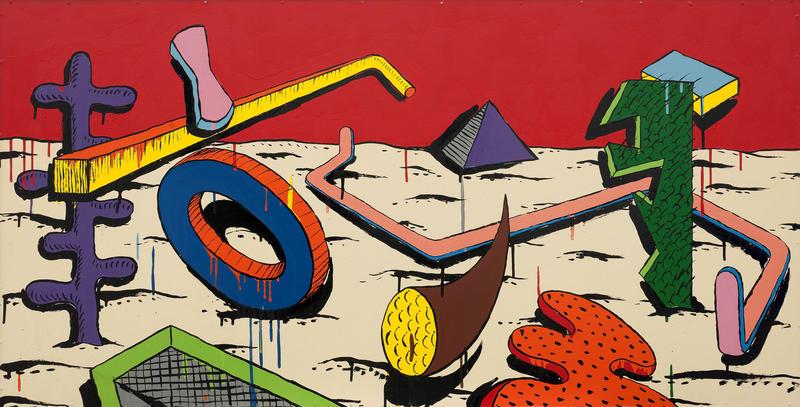ARTISTS George Baloghy, Gavin Chilcott, Dick Frizzell, Paul Hartigan, Richard Killeen, Denys Watkins, Wong Sing Tai CURATOR Francis Pound ORGANISER Auckland City Art Gallery OTHER VENUES Auckland City Art Gallery, 21 February–23 March 1983; Robert McDougall Art Gallery, Christchurch, 12 August–11 September 1983 PUBLICATION Essays Francis Pound, Andrew Bogle
Auckland City Art Gallery mounts a series of shows called Aspects of Recent New Zealand Art. New Image (1983) centres on postmodernist image play, The Grid (1983) on formal abstraction, Anxious Images (1984) on expressionism, and Sculpture 1 and 2 (1986) on sculptural installation.
Guest curated by art critic Francis Pound, New Image heralds a new postmodernist sensibility in painting. The artists are all from Auckland. With one exception, they are all Pound’s team. He has already championed them in his article ‘The New Image Painters’ in Art New Zealand (no. 22, Summer 1981–2). Pound identifies with their post-pop sensibility; the fun and games they have with images and art history; their lightness, humour, and formal wit. He offers them as an antidote to our tradition of expressive-realist New Zealand art based in landscape. The works in New Image range from refined, detailed, illustrative renderings to a kind of pop-primitivism.
The crisp end is typified by Dick Frizzell, Denys Watkins, and Wong Sing Tai. Frizzell’s enamel paintings riff off famous art, package designs, and comics. In Self Portrait as a Serious Artiste, he poses on the cover of Rolling Stone. Denys Watkins precise line drawings, filled in with—like Gertrude Stein Discovers Rangitoto and Morris Louis Staining Device—crack art jokes. Wong Sing Tai makes hard-edge glass paintings of space ships, of a western desert landscape, and of a wobbly Mondrian).
The pop-primitivism end is typified by Gavin Chilcott and Paul Hartigan. Both make stylised, highly abstracted works, featuring retro 1950s comic-book shapes, palette, and feel. In Chilcott's delicate coloured-pencil drawings and lurid unstretched canvases, abstract shapes stand in for human people. Hartigan’s Primary School renders three chocolate fish in primary colours, while his landscapes on mirror glass force viewers to see themselves as implicated. (Hartigan will soon be known for his neon signs featuring crude hand-drawn-style pictographs. A detail from one—The Plight of Persephone (1983)—is reproduced on the catalogue’s cover, although not included in the exhibition checklist.)
Bridging these approaches, the most significant artist is arguably Richard Killeen. His ‘cutouts’ are collections of painted cut-out images, which can be arranged in any order and prompt free-associational interpretation from the viewer. In the next few few years, with Pound’s help, Killeen will dominate discussions about postmodernism in New Zealand art.
An eighth artist, George Baloghy, appears to be a Gallery ring in. He isn’t mentioned in Pound’s catalogue texts (or his Art New Zealand essay), but is addressed in a seperate essay by Gallery curator Andrew Bogle. His paintings combine found images to make art jokes: he conflates Charles Heaphy's and Christopher Perkins’s iconic Taranaki paintings, adding a sealed road and parked cars; a Maori warrior is transposed into a Magritte scene; a plate of meat and three vege is placed on an Ian Scott Lattice painting, as if to reduce this arch modernist icon to a tabecloth. While Baloghy has much in common with the other New Image artists, his sensibility is different. Interestingly, in the catalogue, artists appear in reverse alphabetical order, placing Baloghy last rather than first.


